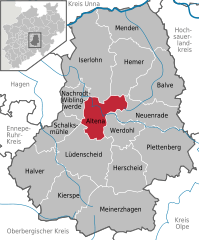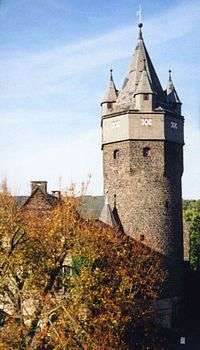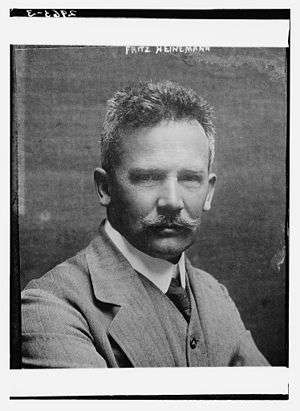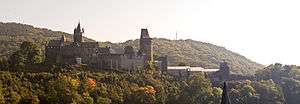Altena
| Altena | ||
|---|---|---|
|
View of Altena Castle in September 2008 | ||
| ||
 Altena | ||
Location of Altena within Märkischer Kreis district 
 | ||
| Coordinates: 51°18′0″N 07°40′0″E / 51.30000°N 7.66667°ECoordinates: 51°18′0″N 07°40′0″E / 51.30000°N 7.66667°E | ||
| Country | Germany | |
| State | North Rhine-Westphalia | |
| Admin. region | Arnsberg | |
| District | Märkischer Kreis | |
| Government | ||
| • Mayor | Dr Andreas Hollstein (CDU) | |
| Area | ||
| • Total | 44.29 km2 (17.10 sq mi) | |
| Population (2015-12-31)[1] | ||
| • Total | 17,375 | |
| • Density | 390/km2 (1,000/sq mi) | |
| Time zone | CET/CEST (UTC+1/+2) | |
| Postal codes | 58741–58762 | |
| Dialling codes | 02352 | |
| Vehicle registration | MK | |
| Website | www.altena.de | |
Altena (![]() pronunciation ; Westphalian: Altenoa) is a town in the district of Märkischer Kreis, North Rhine-Westphalia, Germany. The town's castle is the origin for the later Dukes of Berg. Altena is situated on the Lenne river valley, in the northern stretches of the Sauerland.
pronunciation ; Westphalian: Altenoa) is a town in the district of Märkischer Kreis, North Rhine-Westphalia, Germany. The town's castle is the origin for the later Dukes of Berg. Altena is situated on the Lenne river valley, in the northern stretches of the Sauerland.
History
Altena Castle was built in the early 12th century, as a stronghold of the older Counts of Berg. A short time later a village was founded beneath the hill, with the castle alongside the river Lenne. After the distribution of the Berg family estates in 1161, Altena became the centre of the County of Altena. The first Count of Altena became Eberhard I, Count of Berg-Altena. In 1180, after the death of the first count, the county was divided between the two oldest sons: Arnold of Altena and Friedrich of Altena. The third son, Adolf of Altena, became Archbishop of Cologne. Arnold was provided with on half of the Castle and County of Altena, the Castle Hövel and some estates as fiefdoms of the Archbishops of Cologne and bailiwicks of the Abbey Essen. Near the Village and Castle of Hövel, he built the Castle and town of Nienbrügge (Novus Ponte) on the Lippe riverbanks. His family branch renamed themselves after selling their half of Altena to the Archbishop of Cologne as de Nienbrügge or de Novus Ponte, their new principle residence about forty kilometers to the north. The heir of Arnold was Friedrich de Novus Ponte (Nienbrügge) who changed his title to Isenberg after his new castle in Hattingen. He was sentenced to death as head of the conspiration to murder Engelbert I. Archbishop of Cologne, Chancellor of the Holy Roman Empire, Duke of Westphalia and Count of Berg - a close relative - in 1226. The Archbishop was ambushed and slain on his way from his City of Soest to City of Cologne by Friedrich and his men near Gevelsberg in a hollow way. Both had a dispute over the bailiwicks of Essen Abbey.
The junior branch of the Counts of Altena, was founded by Friedrich de Altena. He was provided with the other half of Altena and a vassal to his brother the Archbishop of Cologne. In or around 1170 he bought the Oberhof Mark or was rewarded with it by the Archbishop. The Oberhof was a mayor manor without fortifications in the village of Mark, between the Lippe and Ahse rivers less than five kilometers to the east of the Nienbrügge Castle and about seven kilometers southeast of Hövel Castle. Today, about a 1,5 kilometers to the east of the centre of the city of Hamm. Before or in 1198 he built the Castle of Mark. His son Adolf I. named himself in 1202 puer comes de marca and became the first Count of Mark. He sometimes used the old title Altena in combination with Mark. His principal residence was the Castle of Mark. After the execution of his cousin Friedrich de Isenberg in Cologne, he destroyed the Castle of Neinbruegge and took over the possessions of the senior family branch.
After 1202, Altena Castle was only one of several Stronghold of the family of Altena-Mark. During a feud in 1323 between the Prince-Bishop of Münster and the Count of Mark, the Bishop was captured and hold for ransom in Altena. In 1367 the settlement below the castle received limited town rights through Engelbert III. Count de la Mark. Since 1392 Altena remained only the seat of the bailiff for bailiwick Altena. The castle was also used as an archive for documents and patents for the county.
In 1609 the last count died childless. His realm, the United Duchies of Jülich-Cleves-Berg were practically divided into a catholic and a prostestant part. The Duchy of Cleves and the counties of Mark and Ravensberg, and the Dominion of Ravenstein were inherited by the Protestant Elector of the Holy Roman Empire, Margrave of Brandenburg, and Duke of Prussia Johann Sigismund of Hohenzollern. The catholic Duchy of Jülich-Berg were inherited by the Count Palatine Wolfgang Wilhelm of Neuburg.
During the Napoleonic occupation of the Rhineland and Westphalia, Altena was re-joined with the now elevated Grand Duchy of Berg. After the Congress of Vienna the County of Mark was incorporated into the Kingdom of Prussia and reorganized as a district (Kreis) and government district (Regierungsbezirk). Altena became part of the Regierungsbezirk Hamm and was seat of the Kreis Altena. Within the year 1815 the Government moved the quarters from Hamm to Arnsberg, and changed the name into Regierungsbezirk Arnsberg.
With the start of the year 1969 the Kreis Altena and the town Lüdenscheid were merged to form the new Kreis Lüdenscheid. Lüdenscheid became the new administrative center of the district. Only six years later the Kreis Lüdenscheid was reformed and enlarged. In reminiscence of the County of Mark it was renamed as Märkischer Kreis.
Points of interest

The town's biggest attraction is the castle: Burg Altena. After being un-used for centuries it was in ruins, although part of the buildings was used as a hospital. A complete restoration was undertaken in 1909 to celebrate the 300th anniversary of the Prussian incorporation of the county of Mark into Prussia (Brandenburg). However, most of the work did not finish before 1914; the celebrations were then held at Hohensyburg Castle.
In 1912 the world's first youth hostel was created by Richard Schirrmann inside the castle. The old rooms are still on display, and new rooms inside the castle area are still part of the hostel today.
The dominant industry in Altena was wire production, and thus it has a museum dedicated to this industry only, the Drahtmuseum.
See also: Burgrock
Coat of arms
The coat of arms shows Catherine of Alexandria, the patron saint of the church built in 1310. She is depicted with a sword and a wheel, as she was killed in 307 by these two items. The choice of patron saint goes back to a vow made by Count Engelbert III of the Mark made at the burial place of Catherine in Jerusalem. The red and white checked fess refers to the coat of arms of the Counts of the Mark.
The coat of arms is quite old: a seal from the 15th century already depicts the same elements. In its current design it was created by Otto Hupp in 1938.
Twin towns
Altena is twinned with:[2]
-
 Péronne, France (since 1967)
Péronne, France (since 1967) -
 Blackburn, Lancashire, England, UK (since 1972)
Blackburn, Lancashire, England, UK (since 1972) -
 Pinsk, Belarus (since 1990)
Pinsk, Belarus (since 1990)
Friendship city
Altena is a friendship city with:
-
 Owensville, Missouri, United States (since 2005)
Owensville, Missouri, United States (since 2005)
Sons and daughters of the town

- Fritz Berg (1901–1979), first president of the Federation of the German Industry after Second World War
- Herbert Berg (1910–1938), racing driver
- Jason Dark, pseudonym of the writer Jason Dark (born 1945 in Dahle)
- Fritz Heinemann (1864–1932), sculptor
- Friedrich Sieburg (1893–1964), literary critic, journalist and writer
References
- ↑ "Amtliche Bevölkerungszahlen". Landesbetrieb Information und Technik NRW (in German). 18 July 2016.
- ↑ "Partnerstädte / Patenschaften". Retrieved 1 May 2014.
External links
| Wikimedia Commons has media related to Altena. |
- Official site (German)
- Official website of Burg Altena (German)
- German American Club (German) (English)

